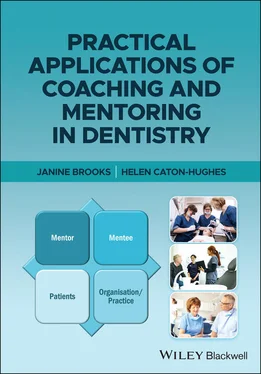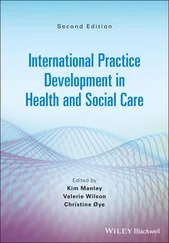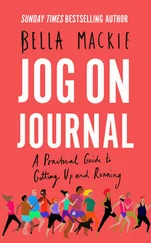Advice‐giving may include technical advice or business advice, and it's vital that mentors only give advice within the boundaries of their professional competencies and experience.
By comparison, a coach may offer examples from their own experience, but expect the coachee to use that example as a story or metaphor, for them to make sense of within their own context rather than as advice‐giving.
This is not to set up either mentoring, coaching, or indeed any talking approach as ‘better’ or otherwise. Each has their role and benefits. The authors have been retained professionally as consultants, coaches, and mentors; their clients may, or may not, have been working separately with therapists or advisers. These are not competing modalities, rather they can be complementary. The mentee is an autonomous adult, capable of making their own decisions about what they need, and who they need to work with, in order to be personally and professionally successful.
Coaching and mentoring is also a style of leadership (Goleman et al. 2001) which can be summarised as a style of leadership that takes into account, and brings together what a person wants with the organisation’s goals.
Table 1.1A comparison of various interventions.
|
Therapy |
Mentoring |
Consulting |
Coaching |
| Focus of work |
Deals mostly with a person's past and trauma, and seeks healing. |
Deals mostly with succession training, and seeks to help the one being mentored to do as the mentor does |
Deals mostly with problems and seeks to provide information (expertise, strategy, structures, methodologies) to solve the problems |
Deals mostly with a client's present, and seeks to guide the client into a more desirable future. |
| Relationship |
Doctor‐patient relationship (therapist has the answers) |
Older/wiser‐younger/less experienced relationship (mentor has the answers) |
Expert‐person with problem relationship (consultant has the answers) |
Co‐creative equal partnership (coach helps client discover own answers) |
| Emotions |
Assumes emotions are a symptom of something wrong |
Is limited to emotional response of the mentoring parameters (succession, etc.) |
Does not normally address or deal with emotions (informational only) |
Assumes emotions are natural, and normalises them |
| Process |
The therapist diagnoses, and then provides professional expertise and guidelines to give the client a path to healing. |
The mentor allows student to observe mentor's behaviour, expertise: answers questions; provides guidance and wisdom for the stated purpose of the mentoring. |
The consultant stands back, evaluates a situation, and then tells client the problems and how to fix it. |
The coach stands with the client, and helps the client identify the challenges. Then they work together to turn challenges into victories. The client is held accountable to reach his or her desired goals. |
Coach‐like leaders and managers have conversations with their staff that go beyond short‐term concerns, individual performance or team goals, and instead explore the person's life, including their dreams, life goals, and career hopes. This coach‐like leaderships style has been identified as a key factor of better employee engagement (Engage for Success 2009), notably the ‘Four Enablers’ of engagement.
Having outlined some key differences between interventions we can move onto think about how the book is structured.
Chapter 2provides an outline of the mechanics of mentoring. This is an opportunity to consider the who and why of mentoring. The characteristics of mentoring and being a mentor are reviewed. We explore what mentoring can achieve and the different types of mentoring. There is a section on criteria that can help when choosing a mentor. The ethics of mentoring are also an important consideration in this chapter.
Chapter 3reviews coaching: looking at what we mean by coaching, including definitions from the major coaching bodies. It also looks at some of the underpinning ideas or theories that inform coaching and which distinguishes this type of conversation from others, including differences between ‘mentoring’ and ‘coaching’. This theory is applied through the practical skills covered in the following chapter.
Chapter 4considers models used within mentoring and coaching with particular emphasis on the Forton model which is used extensively in our qualifications.
Chapter 5is the key focus of the book, the case studies. Here we include 12 case studies generously provided by each of our contributors. The case studies are real examples of how to use mentoring practically within dentistry in the UK. The studies have been grouped into five categories which include: dentists in difficulty; evaluation; early years – undergraduates, foundation dentists, and post foundation; general practice; and organisational culture and models/tools. They showcase the diversity of using mentoring alongside mentoring tools and related techniques.
Chapter 6covers discussion and conclusions. In this final chapter we review some of the lessons learned from the case studies and important themes that thread through. Communication is an aspect that can be found across the case studies and the categories of study. We look at some myths around mentoring and attempt to bust those myths. Looking beyond 1 : 1 mentoring is discussed as we consider team mentoring. Boundaries and barriers to mentoring also figure in the discussion and we conclude with a call for more case study contributions, to build on the body of knowledge, and with pointers for the way forward for coaching and mentoring in dentistry.
We invite you to apply choice in how you use this book! Some people like to read cover to cover, and the format also encourages dipping into a chapter at a time, depending on your preferred approach.
This is a ‘text book’, in as much as any book about coaching or mentoring can be; specifically for the post‐graduate qualification programmes we teach. We also hope that dental professionals around the world will use this book as a starting point for developing their own skills and setting out on their own coaching and mentoring journey.
Inspiration is a personal experience, and yet we aspire to inspire. We hope this book will inspire you to find a coach or mentor, or to try out the coaching approach in your role as leader or manager or indeed to train to become a mentor or coach.
We also hope that you'll use this book to find out more about coaching and mentoring; we offer references at the end of each chapter and a ‘Further Reading’ list at the end of the book. We also invite you to get in touch with the authors, through the websites listed in the ‘Further Reading’ section.
1 Clutterbuck, D. (2001). Everyone Needs a Mentor: Fostering Talent at Work. Chartered Institute of Personnel and Development.
2 Colley, H. (2002). A ‘rough guide’ to the history of mentoring from a Marxist feminist perspective. Journal of Education for Teaching 28 (3): 247–263.
3 Department of Health (2004). The NHS knowledge and skills framework and the development review process.
4 Engage for Success (2009) https://engageforsuccess.org/the‐four‐enablers.
5 Gallwey, T., (1974) The Inner Game of Tennis. Joanathan Cape.
6 General Dental Council (2017). Shifting the Balance, A better, fairer system of dental regulation.
7 General Dental Council (2020). Moving upstream p.32.
Читать дальше












